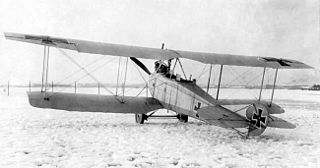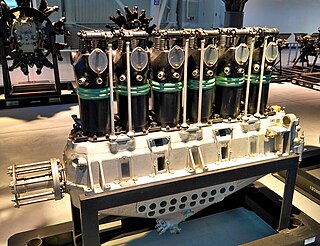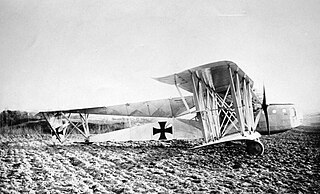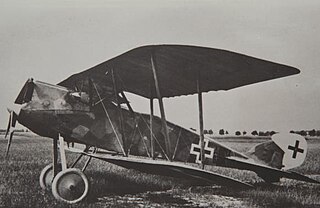
The Albatros C.III was a German two-seat general-purpose biplane of World War I, built by Albatros Flugzeugwerke. The C.III was a refined version of the successful Albatros C.I and was eventually produced in greater numbers than any other C-type Albatros.

The Aviatik C.I was an observation aircraft which came into service during World War I in April 1915. It was a development of the Aviatik B.I and B.II models, being one of first aircraft of the new German C class of armed biplanes. In the C.I the observer sat in front of the pilot, with a machine-gun clipped on a sliding mounting fitted on a rail at either side of the cockpit. It gave the crew the means to attack enemy aircraft. The positions of the pilot and observer were reversed in last series of 50, ordered in 1917 solely for trainer purpose. There was only one aircraft built of refined C.Ia version in May 1916, with armament still in a forward cab, serving as a prototype for C.III. Later models of the plane included the Aviatik C.II and the C.III, which had more powerful engines. The C.III was produced in large numbers.
Luft-Fahrzeug-Gesellschaft, also referred to as LFG, was a German aircraft manufacturer during World War I. They are best known for their various "Roland" designs, notably the Roland C.II Walfisch (whale), Roland D.II haifisch (Shark) and Roland D.VI, although they also produced a number of airships and many experimental designs.

The LVG C.VI was a German two-seat reconnaissance and artillery spotting aircraft used during World War I.

The Benz Bz.IV was a German six-cylinder, water-cooled, inline engine developed for aircraft use. Deliveries began in 1916, and some 6,400 were produced.

The Halberstadt C.V was a German single-engined reconnaissance biplane of World War I, built by Halberstädter Flugzeugwerke. Derived from the Halberstadt C.III, with a more powerful supercharged 160 kW (220 hp) Benz Bz.IVü engine, it saw service only in the final months of the war. Cameras were mounted in the observer's cockpit floor.

The Friedrichshafen G.II was a heavy bomber aircraft that was designed and manufactured in Germany during World War I by Flugzeugbau Friedrichshafen. The plane was used by the Luftstreitkräfte for tactical and limited strategic bombing operations.
The Aviatik C.VI was a prototype German biplane observation aircraft built by Aviatik during World War I. Based on the earlier Aviatik C.V, the C.VI had a more powerful engine and had other improvements. Only a single aircraft was built.

The Roland D.VI was a German fighter aircraft built at the end of World War I. It lost a fly-off to the Fokker D.VII, but production went ahead anyway as insurance against problems with the Fokker.
The Siemens-Schuckert R.I was a bomber aircraft built in Germany during World War I. It was originally ordered as the Siemens-Schuckert G.I prior to the German Inspectorate of Flying Troops adopting the "R" classification for multi-engine aircraft in late 1915. Some sources refer to the aircraft as the Siemens-Schuckert Steffen R.I, including the name of the brothers that designed it.
The Siemens-Schuckert R.III was a prototype bomber aircraft built in Germany during World War I. It was one of six aircraft based on the Siemens-Schuckert R.I that were originally intended to be identical, but which each developed in a different direction and were designated as different aircraft types by the German Inspectorate of Flying Troops. The aircraft's development was impeded by the unreliability of its Maybach HS engines, and when it was eventually accepted for military service, it was only in a training role.
The Siemens-Schuckert R.IV was a bomber aircraft built in Germany during World War I. It was one of six aircraft based on the Siemens-Schuckert R.I that were originally intended to be identical, but which each developed in a different direction and were designated as different aircraft types by the German Inspectorate of Flying Troops. The Maybach HS engines specified by the Idflieg proved unreliable, but with these engines were replaced by Benz Bz.IV engines, the R.IV saw service on the Eastern Front before being relegated to training duties.
The Siemens-Schuckert R.V was a bomber aircraft built in Germany during World War I. It was one of six aircraft based on the Siemens-Schuckert R.I that were originally intended to be identical, but which each developed in a different direction and were designated as different aircraft types by the German Inspectorate of Flying Troops. Development of the R.V benefited from the experience that Siemens-Schuckert and the Idflieg had gained with the R.II, R.III, and R.IV, particularly in its choice of powerplants, where the R.V was spared from the troublesome Maybach HS engine. Between September 1916 and February 1917, the aircraft saw service on the Eastern Front before it was damaged in an accident and dismantled for spare parts.

The Siemens-Schuckert R.VI was a bomber aircraft built in Germany during World War I. It was one of six aircraft based on the Siemens-Schuckert R.I, which were originally intended to be identical. Each developed in a different direction and were designated as different aircraft types by the German Inspectorate of Flying Troops.

The Zeppelin-Staaken Riesenflugzeuge were a series of very large bomber aircraft - Riesenflugzeuge, usually powered by four or more engines, designed and built in Germany from 1915 to 1919.
The Aviatik D.III was a German prototype single-seater fighter plane from the First World War, designed by Aviatik. It became the basis for the Aviatik D.IV and Aviatik D.V. In November 1917, the plane was first flown, using a 195 hp Benz Bz IIIbo gearless engine. It was of similar design to the Aviatik D.II, and was armed with two LMG 08/15 machine guns. After several tests at Adlershof from February 9–12, 1918, the plane underwent modifications, as requested by the Idflieg. In April, a second prototype, powered by a Benz Bz IIIbm, although several D.III powered by the original IIIbo engine were already under production; however, none of them were ever completed.

The Otto C.I, also known as the Otto KD.15, was a German two-seat biplane reconnaissance and bomber aircraft of the First World War designed and produced by Otto Flugmaschinenfabrik. The C.I was a rare example of an aircraft flown by the Central Powers which had a pusher configuration.

The Aviatik C.IX was a prototype German observation aircraft built by Aviatik in the final months of World War I.
The Aviatik C.VIII was a prototype German observation aircraft built by Aviatik in World War I.
The Aviatik D.VI was a German prototype single-seater fighter aircraft of the First World War, designed by Aviatik.














